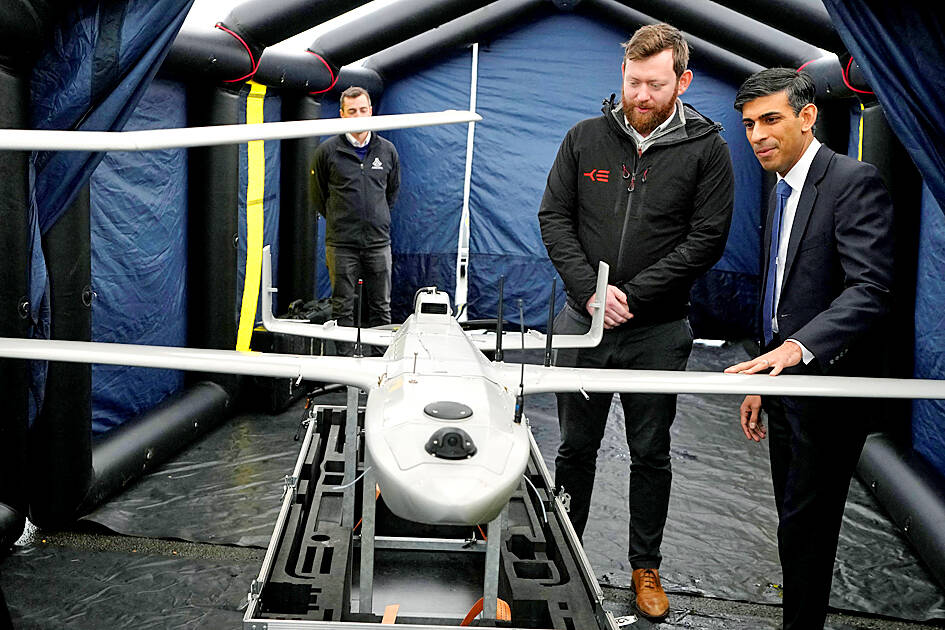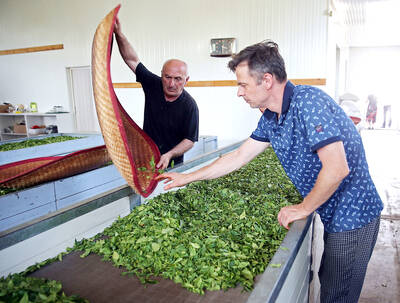In the UK, testing is due to begin this summer on a most remarkable project: a superhighway in the sky for drones.
Spanning about 265km, and extending more than 9km wide and potentially hundreds of meters tall, it could be a Jetsons-esque marvel, turning the UK into a world leader in drone adoption. Backers are confident they have the technology needed. What stands in their way are unanswered policy questions — and the willingness of the public to embrace the future.
The government last year approved Project Skyway, which is backed by a consortium of UK tech start-ups led by Altitude Angel — a Reading, England-based drone air traffic control company — and telecoms giant BT Group PLC.

Photo: Reuters
The first portion of the corridor is planned to connect Reading and Coventry, England. Eventually, the hope is that a network of routes would also connect Oxford, Milton Keynes, Cambridge and Rugby. It could maybe one day extend to the coasts at Southampton and Bentwaters, near Ipswich.
The corridor is intended to eventually consist of multiple layers: Smaller drones carrying packages could move in lower airspace underneath larger drones carrying people.
All of this would be monitored by ground-level sensors looking up and enabling an “automated air traffic control” system that should be interoperable between drone makers without need for extra hardware. If something — such as a helicopter — flies through the corridor, the drones should automatically react to avoid a collision.
Human-carrying drones are a long way off, but lighter payloads, such as packages, are a more immediate possibility. The first tests of the superhighway, due to start in July, would take place in a small part of the corridor and run until autumn. Under scrutiny would be the system’s ability to avoid collisions.
BT, which has backed Altitude Angel with £5 million (US$6.24 million), said that bringing drones to Britain’s skies would be the “dawn of a new era.”
Altitude Angel described it as the most dramatic innovation to transport infrastructure since the advent of rail.
Hyberbole? You do not need to drink any Kool-Aid to see the potential of utilizing our skies for a range of services and functions that are bogged down to roads or existing airways.
A wide-ranging PricewaterhouseCoopers International Ltd (PwC) report said that drones can contribute £45 billion a year to the UK economy by 2030, about 1.6 percent of GDP.
It estimates that 270,000 jobs would be directly created by drones by the same period, with 650,000 more affected by economic benefits from the technology. (This is a net number — the report’s authors said they accounted for jobs that might be lost, such as delivery drivers, as a result of drone adoption.)
The environmental impact, should drones replace some traditional ways of shifting goods or carrying out inspections, could take “around 1.7 million diesel cars off the road” each year, it said.
The report also said that about 900,000 drones would be flying in UK skies annually by 2030.
Here might be biggest hurdle to Project Skyway: It is not unreasonable for some not to want to see drones clogging up the skies.
For the full benefits of the drone economy to be met, it is clear the superhighway would be just the beginning. A promotional video on Altitude Angel’s Web site shows aspirational drone superhighways sprawling across much of Europe. Like a motorway, drones would need to leave the superhighway to get to their final destination — whether it is a business or maybe an Amazon.com Inc customer’s back garden.
It is this potential future that has the public most concerned. A BT-commissioned study assessed attitudes toward the technology and concluded that while some uses — such as searching for missing people or carrying out risky safety inspections — drew broad support, enthusiasm quickly waned for things such as home package delivery or air taxis.
BT director of drones Dave Pankhurst said that he felt tighter regulation over the skies would gain the public’s trust.
Failing to address public concerns risks making the UK fall behind on a major emerging technology with clear benefits. The superhighway could help with that aim, while also providing reassurance as companies push for looser restrictions around piloting drones Beyond Visual Line Of Sight (BVLOS) — the term used for controlling a drone without being able to physically see it.
Countries such as France and Australia are further ahead on BVLOS, PwC said.
Australian grocery chain Coles Supermarkets Australia Pty Ltd has already delivered more than 200,000 orders using drones.
Amazon has stopped testing at a site in Cambridge in favor of building out two trials in California and Texas, where special permission for BVLOS flying was granted by the US Federal Aviation Administration.
Accommodating the same need in the UK has been slower, although the British Civil Aviation Authority has launched a major consultation effort to tackle the question of how a large number of drones might regularly share the skies without incident.
“There is an expectation that this mode of aviation would expand rapidly in the coming years,” the agency wrote in a policy document.
Amazon’s drone team has expressed strong support for the superhighway. They are eager to see it hasten the UK’s progress in establishing the rules of the air, even if its limited geographical cover meant it would not initially be practical for package delivery.
“It’s very positive and shows intent by the government and by the regulator to try to solve the problem,” Amazon spokesman Av Zammit said. “So whether or not we use [the superhighway] is really secondary.”
Rapidly increasing the number of drones in the UK’s skies is a prospect that makes many bristle. Will sunny afternoons now be interrupted by constant buzzing overhead?
However, with advancements in safety and in noise reduction, drones will become an accepted part of modern life. The UK should want to be a world leader. With the superhighway, it can be.
Dave Lee is Bloomberg Opinion’s US technology columnist. Previously, he was a San Francisco-based correspondent at the Financial Times and BBC News.
This column does not necessarily reflect the opinion of the editorial board or Bloomberg LP and its owners.

When Lika Megreladze was a child, life in her native western Georgian region of Guria revolved around tea. Her mother worked for decades as a scientist at the Soviet Union’s Institute of Tea and Subtropical Crops in the village of Anaseuli, Georgia, perfecting cultivation methods for a Georgian tea industry that supplied the bulk of the vast communist state’s brews. “When I was a child, this was only my mum’s workplace. Only later I realized that it was something big,” she said. Now, the institute lies abandoned. Yellowed papers are strewn around its decaying corridors, and a statue of Soviet founder Vladimir Lenin

UNCERTAINTIES: Exports surged 34.1% and private investment grew 7.03% to outpace expectations in the first half, although US tariffs could stall momentum The Chung-Hua Institution for Economic Research (CIER, 中華經濟研究院) yesterday raised its GDP growth forecast to 3.05 percent this year on a robust first-half performance, but warned that US tariff threats and external uncertainty could stall momentum in the second half of the year. “The first half proved exceptionally strong, allowing room for optimism,” CIER president Lien Hsien-ming (連賢明) said. “But the growth momentum may slow moving forward due to US tariffs.” The tariff threat poses definite downside risks, although the scale of the impact remains unclear given the unpredictability of US President Donald Trump’s policies, Lien said. Despite the headwinds, Taiwan is likely

UNIFYING OPPOSITION: Numerous companies have registered complaints over the potential levies, bringing together rival automakers in voicing their reservations US President Donald Trump is readying plans for industry-specific tariffs to kick in alongside his country-by-country duties in two weeks, ramping up his push to reshape the US’ standing in the global trading system by penalizing purchases from abroad. Administration officials could release details of Trump’s planned 50 percent duty on copper in the days before they are set to take effect on Friday next week, a person familiar with the matter said. That is the same date Trump’s “reciprocal” levies on products from more than 100 nations are slated to begin. Trump on Tuesday said that he is likely to impose tariffs

HELPING HAND: Approving the sale of H20s could give China the edge it needs to capture market share and become the global standard, a US representative said The US President Donald Trump administration’s decision allowing Nvidia Corp to resume shipments of its H20 artificial intelligence (AI) chips to China risks bolstering Beijing’s military capabilities and expanding its capacity to compete with the US, the head of the US House Select Committee on Strategic Competition Between the United States and the Chinese Communist Party said. “The H20, which is a cost-effective and powerful AI inference chip, far surpasses China’s indigenous capability and would therefore provide a substantial increase to China’s AI development,” committee chairman John Moolenaar, a Michigan Republican, said on Friday in a letter to US Secretary of